
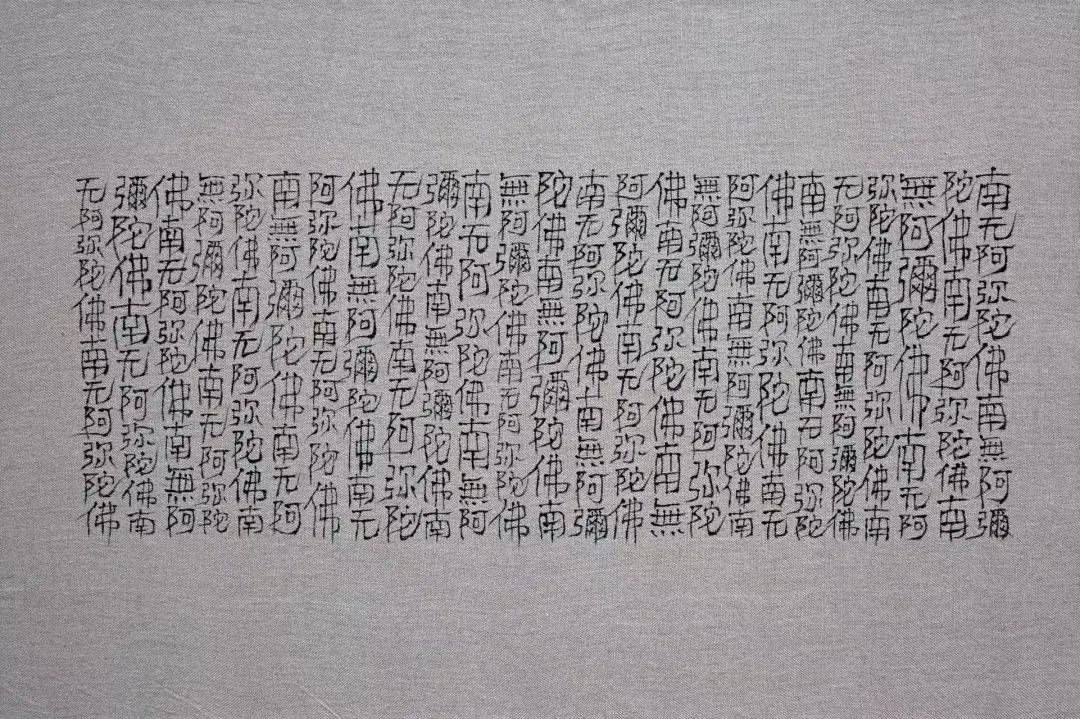
申伟光艺术的生命形式:字字如命
夏可君
汉字的神奇在于,一个个字不仅仅有着语义的具体所指,而且其能指符号还有着多重的表达,这是其它文字都没有的开放性与可变性,并且在历史中获得了丰富的表达:汉字,既有着文字“字体”形式的漫长变化(从甲骨金文到篆书隶书楷书等等),也有着书法“书体”形态学书法性的审美表达(魏晋开始的书法个体化开启不同时代的艺术风格),还有着生命个体或“命体”的生存信念表达或指向救赎的宗教式诉求(从道教符箓到抄写佛教经文直到禅宗书法)。
正是这个“字体-书体-命体”的三一体同时表达,让我们可以重新审视中国现代性书法转换以及当代书写的格局,不同艺术家在不同的维度上突破,比如徐冰就是以字体为主,走向“假字”笔划;比如各种流行书风或丑书是试图在书体上延续与突破,乃至于走向抽象绘画,如同日本的单字或少字的突破;而命体上来看,弘一法师的素体简拙风格,就是一个修行者生命清供的个体化表达。
我们提出“命体”的新范畴,就在于认识到汉字-书法书写的深度,不仅仅是文字使用与审美表达,还与个体命运的“生命形式”(form of life)相关,命体的古代表达是命理学,现代表达则是“生命形式”,传统书法书写虽然也会传达个体的性情与情志,但主要还是审美的意趣,但命体的书写则直指生命自身的“气质变化”与“生命救治”。在疫情之后,在人性生命能量减弱与世界灾变又频发之际,命体的书写更为具有直指救治的价值。
当我们来到北京上苑申伟光老师的美术馆,我们可以看到申老师把不同的汉字字体与书体风格——都指向命体的生命形式书写。申老师从之前的职业绘画,因为个体生命的突变,走向佛教修行,就开始书写佛经,从单子的“佛”到“南无阿弥陀佛”的经咒,从《心经》到《金刚经》,直到几十米长的经文,让人肃然起敬,也望而生畏,这需要什么样的“心力”或一心之力,才可能写出如此坚忍不拔的作品啊!
从书体上看,申老师吸收了汉隶与碑体的瘦硬,但没有更多的装饰笔划,而是带入了生命刺痛感的尖锐,具有生命骨感的疼痛质感,如同荆棘。比如“放下”这几个字,看着就让人心悸,又让人心痛,似乎文字是可触的,这就激发了观看者的生命感知。
我相信,这是申伟光对弘一法师的隐秘继承,但又具有了申伟光自己的生命形式,这是真正个体生命“风骨”的再造,书体就是字体,而字体乃是生命形式的表达,就是要重塑汉字的“金刚体”。
申老师其实是在写字,而主要不是写书法,因为一旦写书法,审美意趣的诱惑就会迫使艺术家走向个体得意的风格炫耀与装饰性效果,但申老师就是要回到写字上,回到一个个的字上,认识这个字的原初含义与生长形式,让一个个字重新获得生命,是获得从未有过的生命质感,这是让一个个汉字重新出生,如同生命在疫情之后需要“重活”(revivre)。字,就成为了生命,字体与书体都转化为生命体,成为心灵书写的表达,是“一心体”,是一心一意的书写,是指向生命救赎的书写,是“心经式”的转念书写。
申伟光的生命书写,乃是用一个个的字,在重复书写中,重构一个新生命。此新生命的书写,有着几种生成方式,我们暂且如此提炼如下:
其一,“圣字体”, 直接书写与佛教相关的大字“佛”,单行的“南无阿弥陀佛”,指向“神圣”庄严与生命祈愿的命体。尤其是当我们在亚麻布上写出的一行“南无阿弥陀佛”,尖锐的笔触就在刺痛我们麻木的心灵与神经,大片的空白就是念叨的回响空间。写字就是在念经,就是在祈祷,进入心咒的能量场。
其二,“重字体”,就是重复写一个字,在重复中,形成不同的字体形式——如同绘画形态,用重复的单一字体形成某种相似性的形态,这是申老师最为明确的生命形式。比如写光明的“光”,在重复书写中形成写一个“佛塔”的形状,也可以形成蜡烛光焰点燃的形态。
其三,“菩提体”或“反成体”,还有一种更为独特的生命形式,就是活用了“烦恼即菩提”的佛理,以“相反相成”的方式让字体具有生命转换的形式自觉,也是采取重复书写的方式,但我们认为可以独立出来,成为一种笔法。比如,以“烦”这个字在重复书写中形成一个“不”的整体形式,“烦恼即菩提”与“菩提即烦恼”就得到了充分的当代表达。再比如,以“有”字的重复书写来建构一个“无”,比如重复书写“慧”而形成一个“空”的形态,就把“空慧”的佛教原理转化生命书写的形式。
其四,“面孔体”,汉字如生命,每一个汉字都是一个个自我投射的面貌,见字如人,人如其字,因此一个个字就是一个个人的面孔,是去除了面具的生命本相,书写汉字就是把生命的本来面目暴露出来,又得到佛力的呵护。申老师写贫困的“困”,那一个个“困”字就像一个生命被捆绑在那里而成为了囚徒,处于挣扎的痛苦之中,宛如一个人面孔活生生的写照。以“足”书写出一个生命自由昂扬行走的姿态,以真理的“真”重构一个面孔脸型,就是用文字来重塑面孔,这是另一种“成佛”的艺术表达。
其五,“淡墨体”,作为画家的申伟光不仅仅改造了形式,对于色彩或墨色也有着沁人心脾的微妙表达,即对于墨的处理非常细微,会用干净的淡墨清水来书写神圣的“圣”这个字,非常的淡,非常的轻柔,进入了一种静默的呼吸状态,写“清凉”两个字也是用一种极干净的淡水淡墨来写就。文字与字形就进入到了生命体的呼吸感知,以及洁净化的感受之中。
在申伟光老师这里,汉字在书写中重新获得了语义和形式的合一,但都指向生命形式的合一,指向生命转化的合一。写字,写书法,就是写命,就是重新书写自己的生命,这就是书写还原到生命的内在关联上,写命也是写心,写出内心一以贯之的虔诚信念,自我见证与自我质变的时空!这也是为什么他反复书写“一心”——这就是一颗心的真切经验,就是一颗心的精炼。如同所有的文学书写都指向某种自我或他者的生命书写(bio-graph),一切的书写都是生命书写的痕迹,也是生命重塑与改变的诉求,是生命重活的祈愿。
写字就是写命,写命就是改命,就是命运的改造,这是另一种的自由书写。字,就获得了生命,文字自身开始自由行走,不再是固定的语义与形式,文字就是生命,文字就是形体。如同“坐”这个字,既是一个字,也是一棵树,还是一个人,立在那里,长在那里,这就是把文字与生命完美合一,也是重塑一个生命的金刚体。因此,当我们再来看那一个个带有尖锐刺感与骨感的字体,其实就不再只是触发刺痛的觉醒,而是浸透着清俊的爽利,乃至于“仙风道骨”的通脱,似乎我们终于可以卸下人生的重负,去掉多余的脂肪,而仅仅剩下干净又纯粹的骨头。
就如同申老师的绘画,实际上就是在建构一个原初的生命体,就像一个个活的细胞,就像孕育生命的卵巢或蜂巢,回到生命最初毛茸茸与繁殖时的生长状态,回到生物体的原生状态,重新开始,这是生命“重活”的创世记。或者把曼陀罗的元素加以个人的提炼,形成一个环状,一个内在的循环,又像花朵,其实就是万物生长的因子或生命的基因,艺术形式才可能成为“元图型”或元图像,这是可以与整个西方的精神分析,尤其是与荣格受到卫礼贤翻译的《金花的秘密》的影响而改写了弗洛伊德的精神病理学对话,走向魂魄转化的能量美学。生命修炼的心魂书写,都是要把生命还原到万物生长的共通因子,如同细菌与植物摆动的纤毛,在我们这个生物学基因重构生命的时代,修行的艺术与改变生命形式的艺术,就与之产生了共感与共振,而申伟光的绘画,还赋予了一种活力,一种光力,画面上有光在回旋,形成金刚体式的钻石感与结晶体。
正是书法与绘画的内在想通,申伟光的创作实际上是用佛教的金刚体转化了汉字与书体,让生命与植物与万物的生长融合在一起,一道道笔划就如同一根根的纤毛,带着鲜活与鲜嫩的触角,生物性的触角与生命书写的笔触就内在触感的融合起来,如同生物细胞的生长,自然的算法与佛力的算法,在一笔一划的书写中,在几十米长佛经的虔诚书写中,塑造出一个成佛的生命,汉字就获得了舍利子一样的神凝之力。
申伟光老师,可以被定义为一个居士书家,或居士的灵性书家,形成了自己独特的“一心书法”,看这些字,既可接纳世俗之心,也可以转向灵心,还可以成就佛心,都是道心的转换媒介。汉字是身位,是生命形式的空间化,这也是为什么申伟光的艺术工作室如同佛堂与教堂,生命书写从来都来自于一个能量巨大的场所,如同莫奈的花园与塞尚的圣维克多山,以及马蒂斯与罗斯科晚期的教堂画,这也是可以给当代艺术以启发的发生方式。
申伟光老师接续曹洞宗的精神理念,让生命能够安宁的坐下来,水月充盈,空慧满照,持续打坐三小时才可能写出巨幅作品,修出清俊而光洁的面容,无论书法还是绘画,其实都是在说:汝皆是佛!如此,才可能“由艺入道”,这是我们这个时代最为需要的艺术疗愈与生命医治之道。

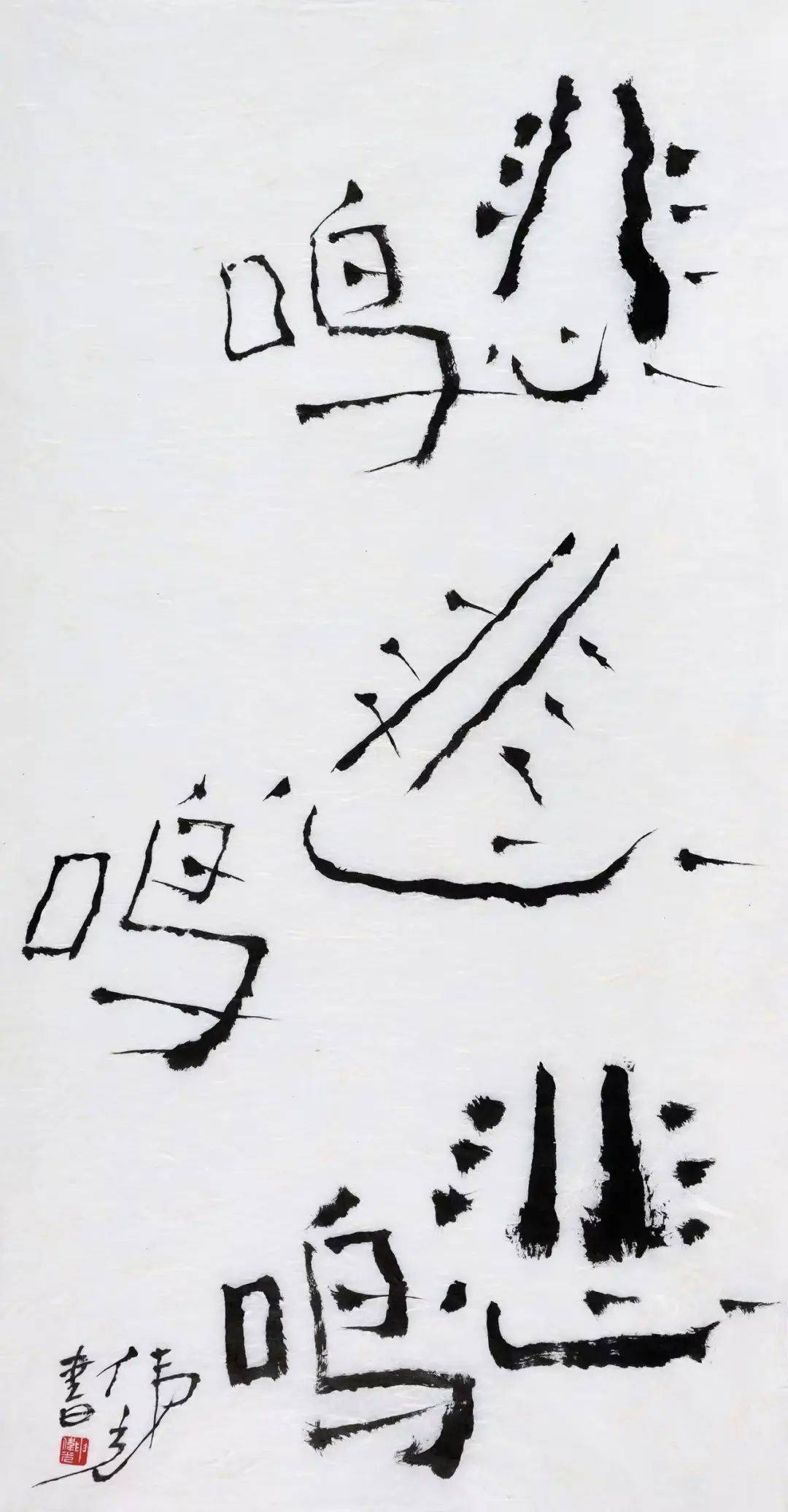


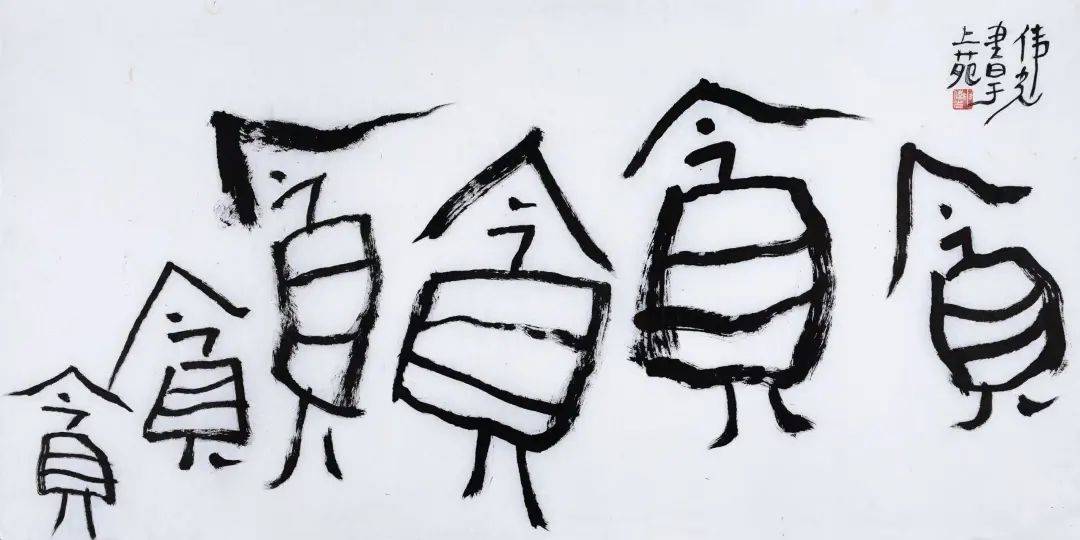
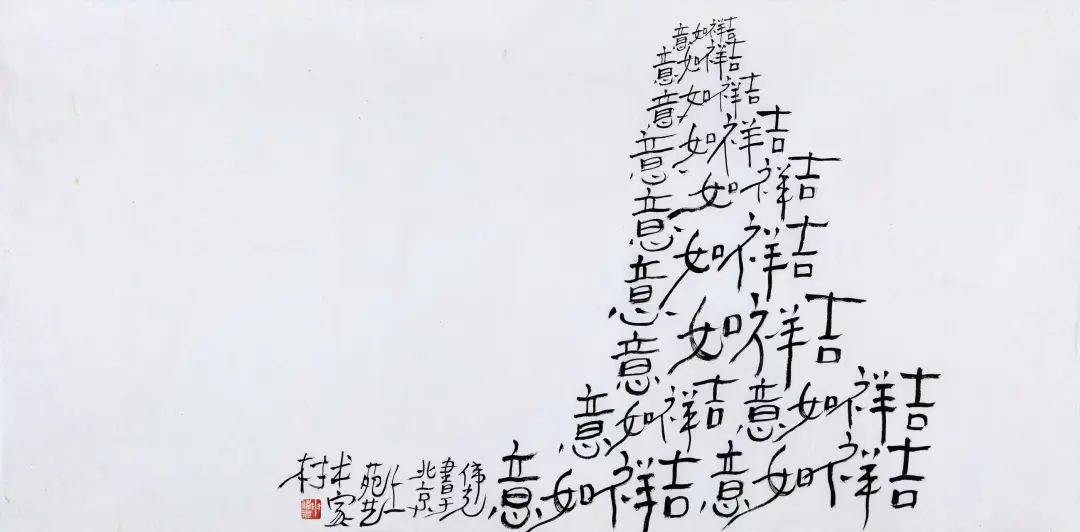

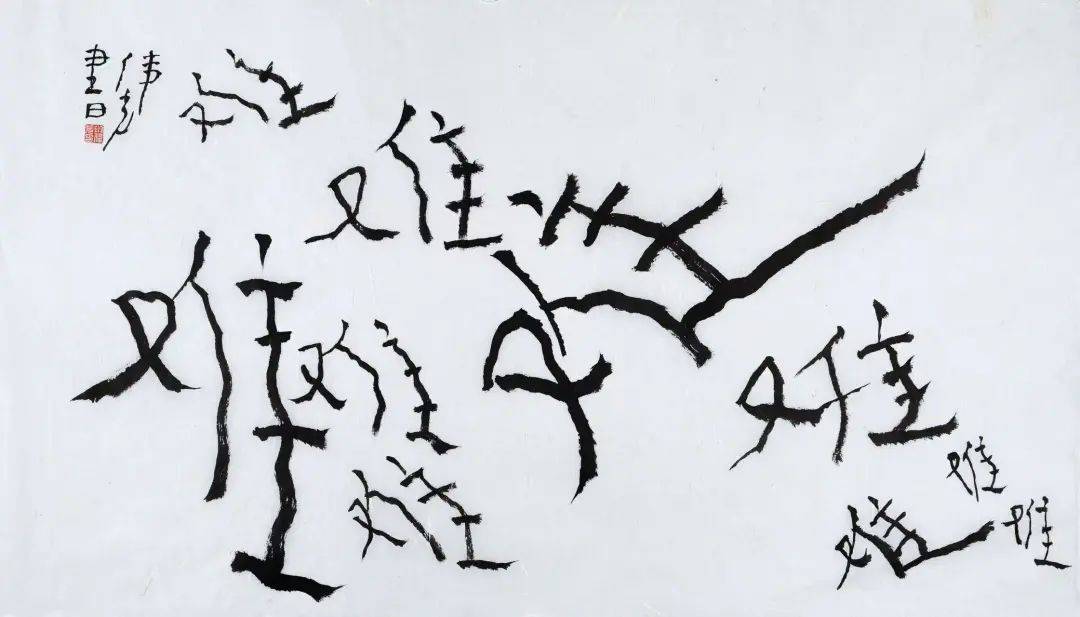
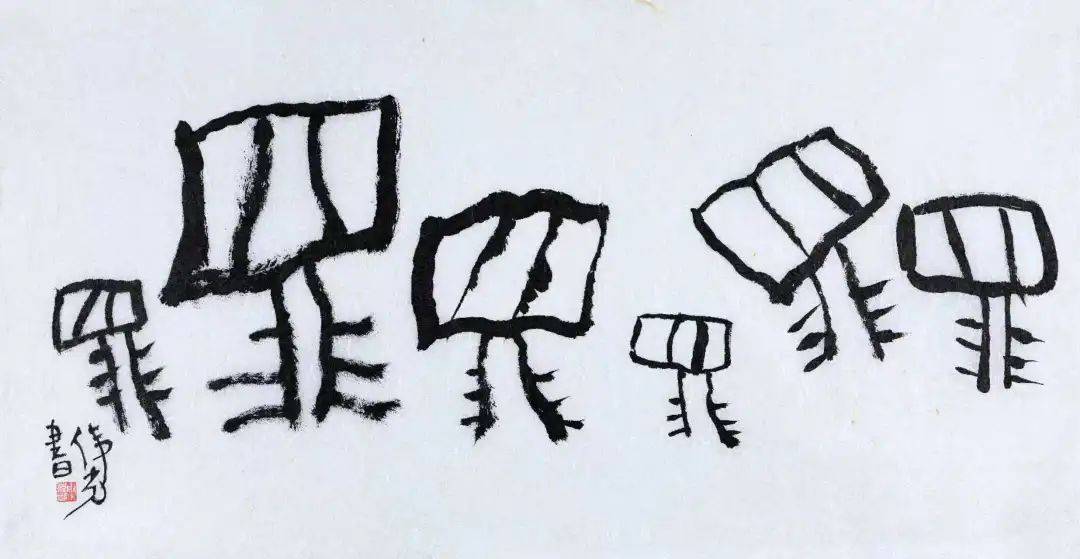
The Life Form of Shen Weiguang's Art: the Vajra Body where Each Character is as Precious as Life Itself
Xia Kejun
It is precisely this simultaneous expression of the trinity of "script form - calligraphy form - life form" that allows us to reexamine the transformation of Chinese modern calligraphy and the landscape of contemporary writing. Different artists make breakthroughs in different dimensions. For instance, Xu Bing focuses primarily on script form and moves towards "pseudo-characters" strokes. Various popular calligraphy styles or so-called "ugly calligraphy" attempt to extend and break through in calligraphy form, even moving towards abstract painting, such as the breakthroughs in Japanese single-character or few-characters calligraphy. From the perspective of life form, the simple and unadorned style of Master Hongyi’s calligraphy represents an individualized expression of a practitioner's purified life offering for spiritual cultivation.
We propose the new category of "life form" to recognize the profound depth of “Chinese character-calligraphy writing”. It is not merely about the use of words and aesthetic expression, but also related to the "form of life" of an individual's destiny. The ancient expression of life essence is numerology, while the modern expression is the "form of life". Although traditional calligraphy can also convey an individual's temperament and emotions, its main focus lies in aesthetic appeal. However, the writing of “life form” directly points to the "transformation of temperament" and "healing of life" inherent to existence itself. After the pandemic, amidst the weakening of human life energy and the frequent occurrence of global disasters, the writing of “life form” holds even greater value in direct healing. Reinventing oneself marks the beginning of a second birth or a “new lease on life”!
When we visit Shen Weiguang Art Gallery in Shangyuan, Beijing, we can see that Mr. Shen has integrated script form and calligraphy form of different Chinese characters, all pointing towards the form of life- the writing of the life form. Due to a sudden change in his personal life, Mr. Shen shifted from his previous career as a professional painter to Buddhist practice, and began writing Buddhist scriptures, ranging from the single character "佛"(Buddha) to the holy name "南无阿弥陀佛"(Namo Amitabha), from the "Heart Sutra" to the "Vajracchedika Sutra", and even to dozens of meters of scriptures. This commands deep respect and evokes awe. What kind of "mental strength" or single-mindedness is required to produce such persevering and unyielding works!
From the perspective of calligraphy form, Mr. Shen has absorbed the lean and rigid characteristics of Han Dynasty clerical script and stele inscriptions, yet avoids excessive decorative strokes. Instead, he has incorporated a sharpness that evokes a sense of life's sting, giving the calligraphy a skeletal, painful texture akin to thorns. For instance, the characters "放下" (Let go) seem to give one a sense of palpitation and heartache just by looking at them. It seems as if the words are tangible, stirring the viewer's visceral connection to life.
I believe this is Shen Weiguang’s subtle inheritance of Master Hongyi’s spirit, yet it has taken on a style uniquely his own—a true re-creation of the individual’s "character and integrity". The calligraphy form is the script form, and the script form is an expression of the life form, which is about reshaping the "vajra body" of Chinese characters.
In truth, Mr. Shen is writing characters, not merely practicing calligraphy. This is because once one delves into calligraphy, the allure of aesthetic appeal can compel the artist to showcase individual stylistic flamboyance and decorative effects. But Shen insists on returning to the act of writing, to the characters themselves—to rediscover their original meanings and their forms of growth, to breathe new life into each character, to endow them with a texture of life that they’ve never possessed before. It is akin to giving birth to each Chinese character anew, much like life itself needing to "revive" after the pandemic. Characters become life, their form and style transform into living entities, becoming expressions of the soul’s writing—a "one-heart style", a wholehearted act of writing, a script that points toward the redemption of life, a "Heart Sutra" style of transformative writing.
Shen Weiguang's life writing is the act of reconstructing a new existence through repetitive writing of individual characters. This writing process of life reconstruction manifests several generative modes, which we tentatively summarize as follows:
First, the "Sacred Script Form" (圣字体), which involves directly writing large Buddhist characters such as "佛" (Buddha) or single line of "南无阿弥陀佛" (Namo Amitabha), points to a solemn and sacred embodiment of life and spiritual aspiration. Particularly when we write a line of "南无阿弥陀佛" on linen, the sharp strokes pierce our numb hearts and nerves, while the vast blank spaces become resonant chambers for the chanting. Writing here is akin to reciting scriptures, to praying, as we enter the energy field of the sacred mantra.
Second, the "Repeated Characters Form" (重字体). It is about repeatedly writing a single character to generate diverse calligraphic forms, akin to painterly structures. The repeated inscription of a single character generates a coherent visual pattern, embodying what Shen Weiguang considers the most definitive form of life. For example, repeatedly writing the character "光" (light) can shape the form of a "Buddhist pagoda", or resemble the flickering flame of a candle.
Third, the "Bodhi Script Form" (菩提体) or "Paradoxical Formation Style" (反成体), which embodies a more unique life form by activating the Buddhist axiom "Affliction is but Bodhi" (烦恼即菩提). Through the method of "opposites complementing each other", this script imbues characters with a self-aware transformation of life. While it also employs repeated writing, we believe it deserves to stand alone as a distinct style. For example, by repeatedly writing the character "烦" (affliction), one can form the overall shape of "不" (not), providing adequately a contemporary expression of the Buddhist principle that "Affliction is Bodhi" and "Bodhi is Affliction". Similarly, repeating the character "有" (existence) can construct the form of "无" (non-existence), and the iterative writing of the character "慧" (wisdom) can form a shape of the character "空" (emptiness), transforming the Buddhist principle of "emptiness-wisdom" into a living form of calligraphy.
Fourth, "Face Script Form"(面孔体). Chinese characters are like life itself—each character is a self-projected visage. The calligraphy reflects the person, and the person is like his calligraphy. Thus, each character becomes a human face stripped of masks—revealing the true essence of life. Writing Chinese characters exposes the raw, unadorned countenance of life, while simultaneously receiving the protective embrace of Buddha’s power. When Mr. Shen writes the character "困" (trapped), each iteration of "困" resembles a life bound and imprisoned, writhing in agony—a vivid portrayal of a human face. By writing "足" (foot), he captures the spirited stride of a free and vibrant life. He reconstructs facial contours with the character "真" (truth)—this is the art of reshaping visages through characters, another artistic expression of “attaining Buddhahood”.
Fifth, "Light Ink Script Form"(淡墨体). As a painter, Shen Weiguang not only reinvents form but also exudes a delicate and refreshing subtlety in his treatment of colors and ink tones. His handling of ink is extraordinarily refined—he writes the character "圣" (holy) with clean, diluted ink and clear water, achieving an ethereal lightness and softness that embodies a state of meditative breath. When writing the characters "清凉" (coolness), he uses the same pure, light ink and water, immersing the text and its form in the rhythm of life's breath and a feeling of purification.
In the hands of Shen Weiguang, Chinese characters regain the unity of semantic meaning and form through the act of writing—yet this unity ultimately points to the unification of life forms, and the unification of life transformations. To write characters, to practice calligraphy, is to write one’s life—to rewrite one’s existence. This is writing restored to its intrinsic connection with life itself: Writing life is writing heart, expressing an unwavering inner devotion, a moment of self-witnessing and self-transformation in time and space. This is why he repeatedly writes “一心” (one heart)—it is the genuine experience of a single heart, the refinement of a single heart. Just as all literary writing points to the act of writing about one’s own or other’s life (bio-graph), all writing becomes a trace of life’s inscription, a plea for life’s reshaping and renewal, and a prayer for life’s rebirth.
To write characters is to write life; and to write life is to transform life—it is the remaking of destiny, a form of free expression in its own right. Characters thus come to life, beginning to walk freely on their own, no longer confined to fixed meanings or forms. Characters become life, and become physical forms. Take for example, the character “坐” (sit)—it is not merely a word but also a tree, a person, standing there, growing there. This represents the perfect fusion of characters and life, the reshaping of a life into a “vajra body”. Therefore, when we look at those characters with their sharp, piercing, and bony forms, they no longer merely provoke a stinging awakening but are imbued with a crisp clarity, even a transcendent freedom of “sage-like type”, as if we could finally shed life's heavy burdens, strip away excess fat, and be left with nothing but clean, pure bones.
Just like Mr. Shen's paintings, they are essentially constructing a primordial life form, akin to living cells, resembling the ovaries or honeycombs that nurture life, returning to the initial fuzzy and reproductive growth state of life, reverting to the primitive state of organisms, and starting anew. This is the genesis of life's "rebirth". Alternatively, by personally refining the elements of the mandala, forming a circular, or a inner cycle, resembling flowers, it becomes the very factor of universal growth or the gene of life. Only through this can artistic forms become "archetypal forms" or meta-images, capable of engaging in dialogue with the entirety of Western psychoanalysis, particularly with Jung, who, influenced by Richard Wilhelm's translation of The Secret of the Golden Flower, redefined Freud's psychopathology, moving toward an energy aesthetics of soul transformation. The soul-writing of life cultivation aims to restore life to the common factors of universal growth, like the swaying cilia of bacteria and plants. In our era of biological gene-reconstructed life, the art of spiritual cultivation and the art of altering life forms resonate and harmonize with this, and Shen Weiguang's paintings further imbue this with a vital energy, and a luminous force. Light swirls on the canvas, creating a diamond-like and crystalline effect akin to the vajra form.
It is precisely the intrinsic connection between calligraphy and painting that Shen Weiguang’s creations transform Chinese characters and calligraphic forms through the Buddhist vajra body, merging life, plants, and the growth of all things. Each stroke is like a strand of cilia, carrying a vivid and tender antennae. The biological antennae and the brushstrokes of life-writing fuse through an inner tactile sensation, akin to the growth of biological cells. The natural algorithm and the algorithm of Buddhist power intertwine in each stroke, in the devout transcription of tens of meters of Buddhist scriptures, shaping a life that attains Buddhahood. In this process, Chinese characters acquire a condensed, sacred power akin to "śarīra" (relics).
Mr. Shen Weiguang can be defined as a lay Buddhist calligrapher, or a lay Buddhist spiritual calligrapher, who has formed his unique "One-Heart Calligraphy". Looking at these characters, one can embrace the secular heart, shift to the spiritual heart, and even cultivate the Buddha's heart, as they all serve as mediums for the transformation of the Dao-heart. Chinese characters are embodiments, and the spatializations of life forms—this explains why Shen Weiguang's art studio resembles a Buddhist temple or a church. The act of life-writing always originates from spaces of immense energy, akin to Monet's garden, Cézanne's Mont Sainte-Victoire, and the chapel paintings of Matisse and Rothko in their later years. This is also a way to inspire contemporary art.
Mr. Shen Weiguang inherits the spiritual essence of the Pure Land Sect’s Buddha-recitation practice and the Caodong Zen, allowing life to settle into tranquility, where the moon’s reflection fills the water and the wisdom of emptiness shines brightly. Only after three hours of continuous meditation can he produce grand-scale artwork and cultivate a serene and radiant countenance. Whether in calligraphy or painting, his art ultimately proclaims, “You are all Buddhas!” In this way, it becomes possible to "enter the Dao through art". This is the path of artistic healing and life therapy that our era needs most, allowing life to experience a second birth or be truly lived anew!

展出时间:
2025.5.24~2025.7.24
展出地址:
申伟光美术馆朝阳分馆
(北京市朝阳区来广营乡红军营路23号院8号楼)
(导航搜索:申伟光美术馆朝阳分馆)

申伟光先生简介
Introduction to Mr. Shen Weiguang
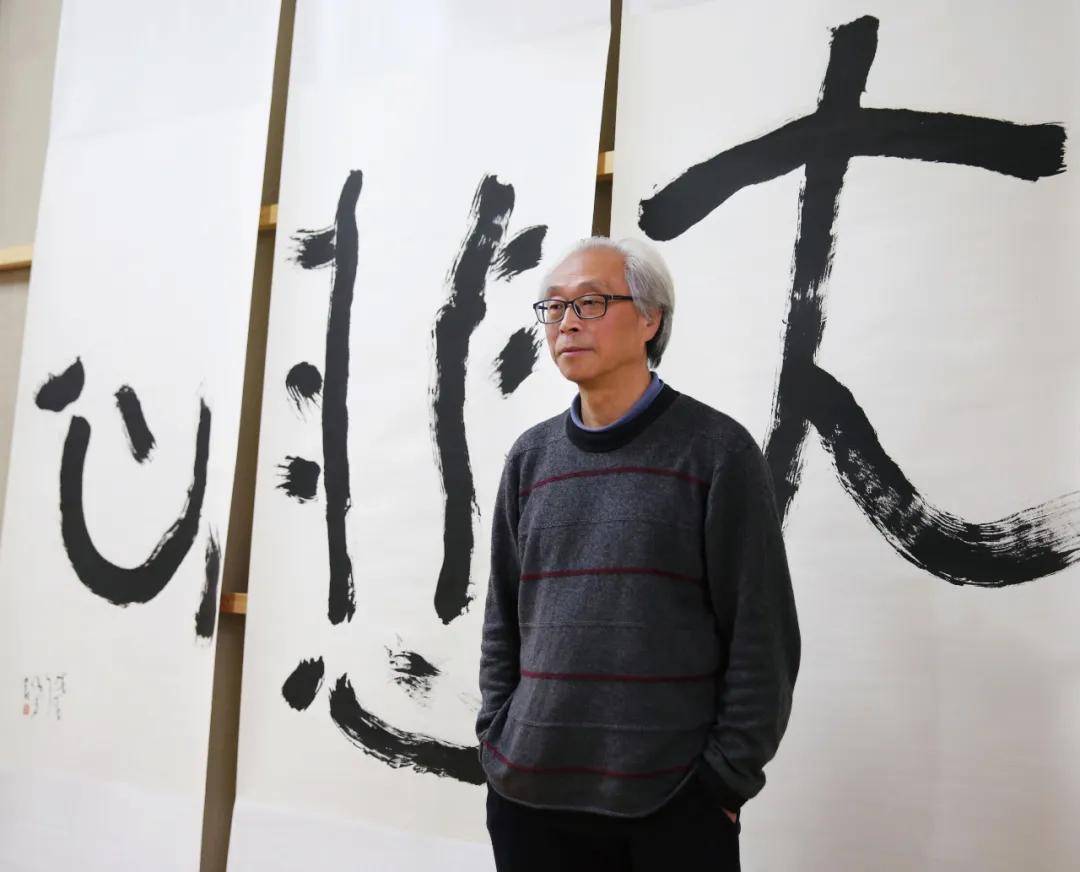
申伟光,中国当代著名艺术家、水墨画家、书法家,居士。
1959年生于河北邯郸市。1981年毕业于华北理工大学艺术学院。1988年结业于南京艺术学院。1991年笃信佛教。1994年入住北京圆明园画家村。1997年定居北京上苑艺术家村。2021年8月30日,申伟光美术馆(北京)成立。2022年3月17日,申伟光美术馆邯郸分馆成立,2025年4月16日申伟光美术馆朝阳分馆成立。
作品曾参加第六届全国美展、第八届全国美展、广州首届九十年代艺术双年展、首届中国艺术三年展、上苑艺术家工作室开放展、今日美术大展、“文脉当代中国版本”大型综合艺术展、超验艺术展、2008奥林匹克美术大会等艺术大展,并于北京今日美术馆、南京艺术学院美术馆等地多次举办大型个人画展,其艺术成就在中国当代艺术中独树一帜。
已出版作品集《申伟光作品》《申伟光艺术20年》《超验艺术》《申伟光超验绘画》《申伟光水墨》《申伟光书法作品集》《申伟光书写圣号作品集》《申伟光书法集》《申伟光重字书作品集》《申伟光写生作品集》。出版艺术研究文献《申伟光超验艺术评论集》《纠结与超脱——申伟光油画作品评论集》《申伟光艺术精神评论集》《净行——一艺术家群落修学与生活纪实》。出版个人著述《申伟光谈话录》《申伟光谈话录(二)》《申伟光谈话录(三)》《申伟光谈话录(四)》《申伟光的话与画》《申伟光谈艺录》《申伟光谈艺录(二)》。
Shen Weiguang is a famous artist, ink painter and calligrapher in contemporary China. He is also a lay Buddhist.
In 1959, he was born in Handan City, Hebei Province. He graduated from the college of Art, North China University of Science and Technology in 1981. In 1988, he completed his studies in Nanjing University of the Arts. He sincerely believed in Buddhism since 1991. In 1994, he moved to the Old Summer Palace Artists Village. He settled down in Beijing Shangyuan Artists Village as a professional artist since 1997. Shen Weiguang Art Museum in Beijing was established on August 30, 2021. This was followed by the opening of the Handan Branch of the Museum on March 17, 2022. Then, the Chaoyang Branch of the Museum opened on April 16, 2025.
His works have been exhibited in major art exhibitions such as the 6th and 8th National Art Exhibitions, the First Guangzhou Art Biennale of the 1990s, the First China Art Triennale, the Open Exhibition of Shangyuan Artist Studios, the Today's Art Exhibition, the "Contemporary Cultural Heritage·Chinese Edition" Large-scale Comprehensive Art Exhibition, the Transcendental Art Exhibition, and the 2008 Olympic Art Conference. He has also held large-scale solo exhibitions many times, such as Beijing Today Art Museum and Art Museum of Nanjing University of the Arts and so on. His artistic achievements stand out uniquely in contemporary Chinese art.
His published works include the following titles: Shen Weiguang's Works, Shen Weiguang's Art Over the Past 20 Years, Transcendental Art, Shen Weiguang's Transcendental Paintings, Shen Weiguang's Ink Paintings, The Collection of Shen Weiguang's Calligraphy Works, Shen Weiguang's Calligraphy Works about the Holy Name of Buddha and Bodhisattva, Shen Weiguang's Calligraphy, Shen Weiguang's Calligraphy Works About Repeated Characters, Shen Weiguang's Sketches.
He has published studies in art research such as Shen Weiguang Transcendental Art Review Collection, Tangled and Detached: Shen Weiguang Oil Paintings Review Collection, Shen Weiguang Art Spirit Review Collection, and Journey of Purity: A Documentary of the Cultivation and Life of an Artist Community.
Shen has also published transcriptions of his conversations with students and lectures: Shen Weiguang's Conversations Volumes 1-4, Shen Weiguang's Words and Paintings, Shen Weiguang's Notes on Art Volumes 1 and 2.
申伟光美术馆简介
Introduction to Shen Weiguang Art Museum
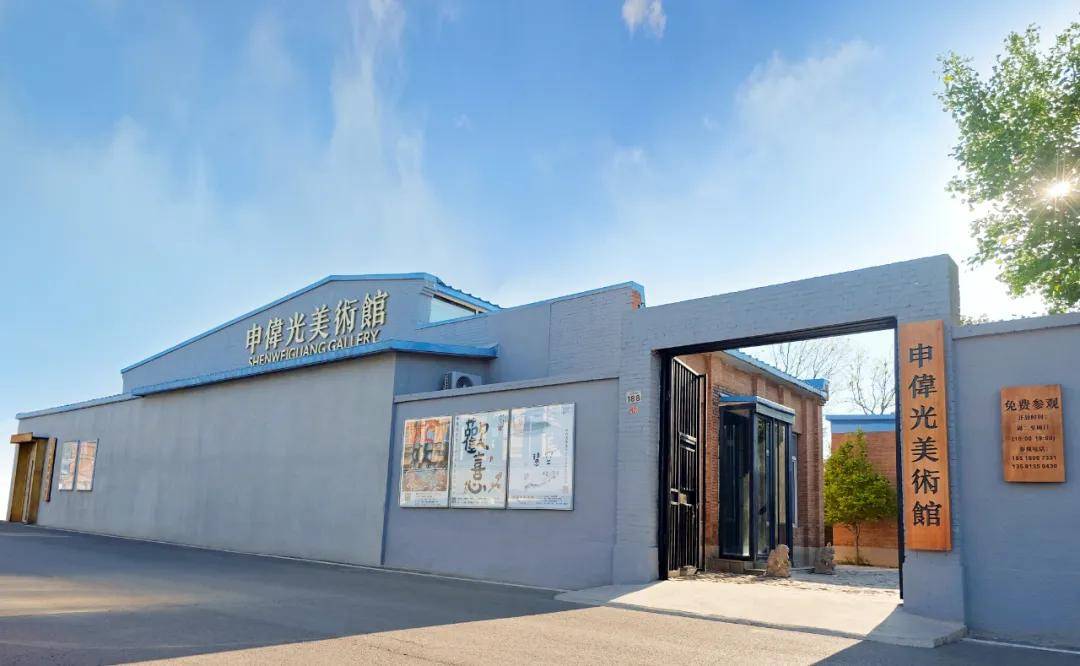
申伟光先生,中国当代著名艺术家、水墨画家、书法家,居士。自上世纪80年代起,即以其作品独特的艺术语言与图式蜚声艺坛,从而确立了他在当代艺术界不可替代的地位。申伟光先生从事艺术创作50余载,多艺并举,跌宕昭彰,独超众类,自成一家,其艺术成就在当代艺术史上独树一帜。
申伟光美术馆是以其个人名字命名的现代化私立美术馆,2021年8月30日,“申伟光美术馆(北京)”成立。2022年3月17日,“申伟光美术馆邯郸分馆”成立。2025年4月16日,“申伟光美术馆朝阳分馆”成立。
申伟光美术馆以收藏、陈列、研究申伟光先生的艺术创作及文献资料为宗旨,主要学术工作包括策划举办展览、组织学术研讨会与座谈会等活动,以及整理、编辑、出版其画册及著述。美术馆致力于推广和传播申伟光先生的艺术精神与作品,是全方位了解其艺术及个人的权威交流平台。
“申伟光美术馆”位于北京上苑艺术家村,建筑面积2000平方米,长期陈列展出申伟光先生油画、水墨、书法等作品共计300余幅。
“申伟光美术馆邯郸分馆”位于河北省邯郸市邯山区中华南大街231号,建筑面积500余平方米,长期陈列展出申伟光先生油画、水墨、书法等作品共计200余幅。
“申伟光美术馆朝阳分馆”位于北京市朝阳区红军营路23号院8号楼,建筑面积500余平方米,长期陈列展出申伟光先生油画、水墨、书法等作品共计200余幅。
申伟光美术馆作为申伟光先生精神人格与艺术精神的延续与载体,将始终秉承先生上求下化的慈悲愿力,致力于成为神圣高贵的艺术殿堂与清净庄严的修学道场,广结艺缘,广结法缘。
Mr. Shen Weiguang is a renowned artist, ink painter, and calligrapher in contemporary China. He is also a lay Buddhist. Since the 1980s, he has been celebrated in the art world for his unique artistic language and patterns, thereby establishing his irreplaceable position in the contemporary art circles. Mr. Shen has dedicated over five decades to artistic creation, and his works in multiple art forms are unconstrained, outstanding, and distinctive. His artistic achievements hold a unique and iconic position in the history of contemporary art.
Shen Weiguang Art Museum is a private art institution named after the artist himself. Shen Weiguang Art Museum (Beijing) was established on August 30, 2021. This was followed by the opening of the Handan Branch of the Museum on March 17, 2022. Then, the Chaoyang Branch of the Museum opened on April 16, 2025.
Shen Weiguang Art Museum is based on the fundamental purpose of collecting, displaying, and studying Mr. Shen Weiguang's artistic creations and documentation. Its main academic works include planning and holding exhibitions; organizing seminars, symposiums, and other academic activities; collating, editing, and publishing art portfolios and writings of Mr. Shen. It focuses on promoting and disseminating Mr. Shen's artistic spirit and artworks, and is an authoritative exchange platform for a comprehensive understanding of Mr. Shen and his art.
Shen Weiguang Art Museum, located in Beijing's Shangyuan Artist Village, spans a floor area of 2,000 square meters. It permanently exhibits over 300 works by Mr. Shen, including oil paintings, ink paintings, and calligraphy pieces.
The Handan Branch of Shen Weiguang Art Museum is located in Building 231, Zhonghua South Street, Hanshan District, Handan City, Hebei Province, with a floor area of over 500 square meters. It permanently displays over 200 works by Mr. Shen, including oil paintings, ink paintings, and calligraphy pieces.
The Chaoyang branch of Shen Weiguang Art Museum is located in Building 8, No. 23 Hongjunying Road, Chaoyang District, Beijing, with a floor area of over 500 square meters. It permanently exhibits more than 200 works by Mr. Shen, including oil paintings, ink paintings, and calligraphy pieces.
As the continuation and carrier of Mr. Shen Weiguang's spiritual personality and artistic spirit, Shen Weiguang Art Museum will always adhere to Mr. Shen's compassionate vow of seeking enlightenment for self and others, is dedicated to making art and Dharma connections with people, and is committed to becoming a sacred and noble art palace, a pure and solemn place for learning and practicing.

申伟光先生更多资讯
欢迎关注申伟光美术馆
-
联系我们
官方邮箱:215596217@qq.com
北京申伟光美术馆
地址:北京市昌平区兴寿上苑艺术家村东路171号
北京申伟光美术馆朝阳分馆
地址:北京市朝阳区红军营路23号院8号楼




